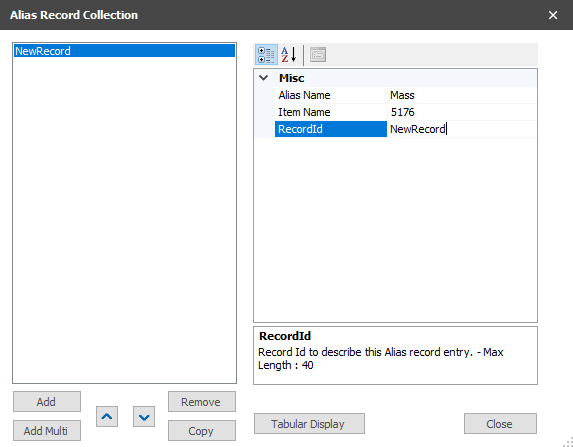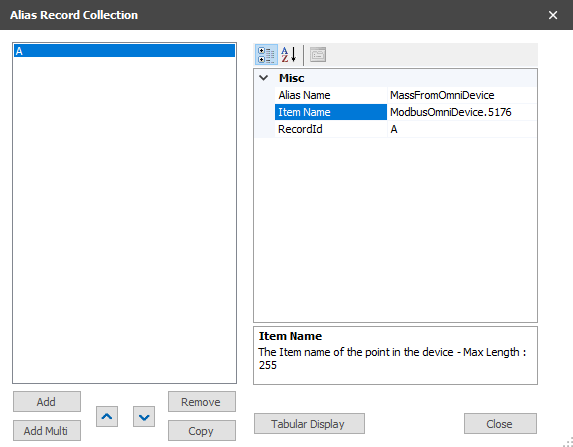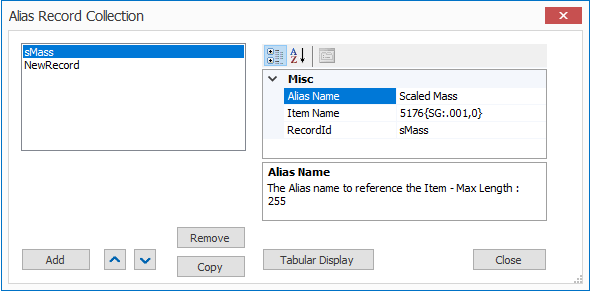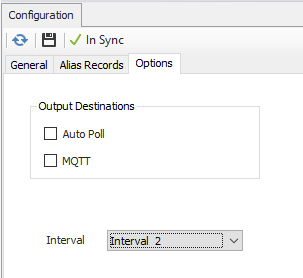Overview
The Alias Group object allows custom item names to be linked to protocol item names. This is particularly useful with numeric item names. An Alias Group can be created for use with a single device, a group of devices of the same protocol (if the item names are the same for devices of the protocol), or for the ACM server. Device level alias groups are assigned on the "Options" tab of the device, and a server level alias group is assigned on the Aliasing tab of the $Server object. Device objects may have multiple alias groups while the $Server object can have only one.
Device Level Alias Groups
To add a device level alias to an Alias Group, enter the alias name to be used by OPC clients and the protocol item that it represents. For example, to create an alias for the modbus register 5176 of an Omni Modbus device, use the alias name "Mass" and the item name "5176".
Server Level Alias Groups
When an alias group is assigned to the $Server object, it is the only alias group used by ACM - overriding all other alias group assignments. To create an alias for use at the server level, the item name property must include both the device name and the item name. A $Server alias object can use a string in any format for the alias name, but the item name must contain the device name and the item name. Using the same example from above, an alias for register 5176 could be entered as "ModbusOmniDevice.Mass" or "MassFromOmniDevice". The item name would be entered as ‘ModbusOmniDevice.5176’ (including the device name).
Item Modifiers
Item modifiers and item scaling can be used in alias groups, but the modifier will be appended to the item name and NOT the alias name. For example if the raw value returned for Mass is 2500 and the scaled value should be .25, the alias name might be entered as ‘Scaled Mass’ and the item name would be entered as ‘5176{SG:.001,0}’. For more information on item scaling, please see Item Scaling section.
Configuration
See the General Object Configuration guide for assistance configuring the General tab.
Alias Records
Edit Records
Click the Edit Records button to open the Alias Record Collection dialog box to add the alias names and item names.
Click Add to enter the appropriate number of New Record items.
Click Remove to delete any unwanted New Record items.
Click Tabular Display to view all New Record items at once.
Alias Name
The name by which the item will be referenced. Max Length: 255 characters.
Item Name
The item name of the point in the device. Modifiers and scaling can appended to the Item Name. Max Length: 255 characters.
Record Id
Used to describe this entry. Max Length: 50 characters.
Saving Record Collection Changes
When record editing is complete, Click Close to return to the owning object type. Click the Save button to save any changes made to the record collection.
Options
Output Destinations
All items in the alias group are sent collectively to the selected destination..
- Auto Poll: When checked, ACM will advise the items in the Alias Group and poll them on the interval specified, even without being advised by an external client.
- MQTT: When checked, ACM will publish the items in the Alias Group via MQTT after they are polled (using the broker settings configured in ACM Monitor).
Interval
This is the schedule interval that is applied to the items in the alias group. This requires that a schedule be assigned to the devices using the alias group, and that schedule must have the interval configured to match (Interval 2 in the above screenshot). If no interval is selected, the items will be polled on interval one as defined in the device’s polling schedule.




.png?version=1&modificationDate=1602621337225&cacheVersion=1&api=v2)
